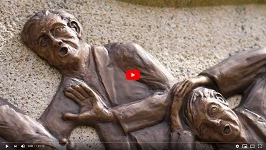Further information
Non-fiction books
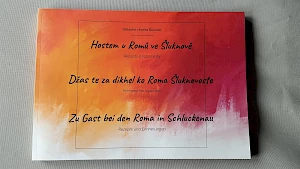 This book brings together recipes and memories from Roma who now live in Šluknov (Schluckenau). The first thing that strikes you when reading the recipes is that they are simple dishes in terms of ingredients - flour and potatoes are the foundation, often combined with cabbage and beans. But what comes out of it in the Roma kitchen is no longer easy, but often very complex. An example of how people who come from a tradition of poverty are often very inventive as to how something different can always be prepared with the little. Sudeten Germans and members of the older generation in general know this from their own experience.
This book brings together recipes and memories from Roma who now live in Šluknov (Schluckenau). The first thing that strikes you when reading the recipes is that they are simple dishes in terms of ingredients - flour and potatoes are the foundation, often combined with cabbage and beans. But what comes out of it in the Roma kitchen is no longer easy, but often very complex. An example of how people who come from a tradition of poverty are often very inventive as to how something different can always be prepared with the little. Sudeten Germans and members of the older generation in general know this from their own experience.
For the public, Roma life is still something of a mystery that little is known about. There are often precise ideas about how Roma “are” and that is all. For this reason, the book also collects stories that have something to do with food in some broad way. Some are full of information, others are funny and some are very sad. This sadness has accompanied the life of the Roma for a very long time.
The book was created as part of community work that the Regionalcaritas Schluckenau has been doing for years. It was compiled with many helpers and contemporary witnesses over the course of three years. The book is in three languages - German, Romany, Czech - and comprises 180 pages. It is illustrated by naive colored drawings by a Roma artist and by children's drawings, by old black-and-white photographs from Roma families (these alone are a contemporary document that is rarely found) and by own photographs.
The book costs 15 euros and can be ordered by mail or post from the Regionalcaritas Schluckenau (Oblastní charita Šluknov): habel@charitasluknov.cz or Oblastní charita Šluknov, TGMasarykova 611, CZ-40777 Šluknov.
(This is an automatic translation by Google Translator.)
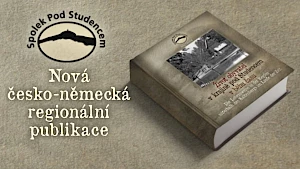 The way of life in the region below the Kaltenberg throughout time
The way of life in the region below the Kaltenberg throughout time
Jitka Tůmová; Spolek pod Studencem (Hrsg.), 2021, 545 pages
The bilingual book is dedicated to the detailed description of the inhabitants of the villages of Kaltenbach (Studený) and Limpach (Lipnice) below the Studenec (Kaltenberg) mountain. For each individual house, the former inhabitants and their history are described, making local life in earlier times vivid and tangible.
The author Jitka Tůmová contacted former inhabitants of the villages, who settled after the expulsion mainly Saxons. Over the course of 13 years, she listened to many stories about life in the villages and collected them in this work. This is supplemented by photographs taken by the author's father in the post-war period.
The publication of the book was sponsored by various institutions and persons, very significantly also by the Euroregion Elbe/Labe.
The book is available at the association Spolek pod Studencem and at selected places such as tourist information offices and museums. It can be ordered online, for example, from the Děčín Museum.
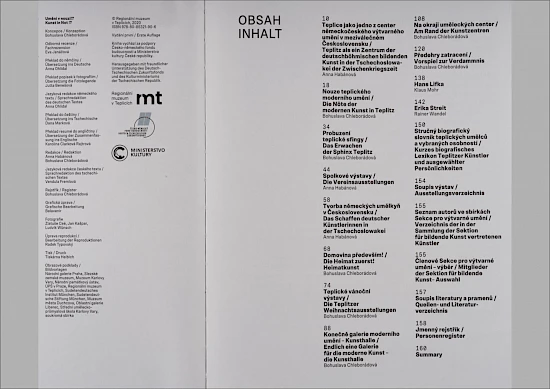 A Czech-German publication presenting the efforts of the Visual Arts Section of the Teplice-Šanov Museum Society to create one of the centers of German Czech art in interwar Czechoslovakia in the years 1932-1938. In 10 chapters it offers an overview of the exhibition, acquisition and educational activities of the section. In 160 pages, this is approached in a broader cultural and social context, and the text is supplemented by 157 reproductions of artworks, archival documents, and postcards and photographs from the streets of what was then Teplice. The graphic design of the museum's gallery evokes the atmosphere of times gone by and attempts to draw attention to the special features of the Teplice Museum's collections.
A Czech-German publication presenting the efforts of the Visual Arts Section of the Teplice-Šanov Museum Society to create one of the centers of German Czech art in interwar Czechoslovakia in the years 1932-1938. In 10 chapters it offers an overview of the exhibition, acquisition and educational activities of the section. In 160 pages, this is approached in a broader cultural and social context, and the text is supplemented by 157 reproductions of artworks, archival documents, and postcards and photographs from the streets of what was then Teplice. The graphic design of the museum's gallery evokes the atmosphere of times gone by and attempts to draw attention to the special features of the Teplice Museum's collections.
The book reveals another unknown view of history of the town of Teplice.
The publication can be purchased for 299 CZK in the museum or ordered at the following address: Regional Museum in Teplice, Zámecké náměstí 14, 415 01 Teplice (or by e-mail: klasterkova@muzeum-teplice.cz).
ISBN 978-80-85321-90-6
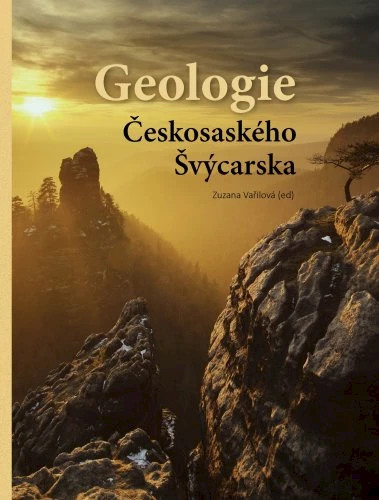 Geology of Bohemian-Saxon Switzerland
Geology of Bohemian-Saxon Switzerland
Zuzana Vařilová (ed.); 2020.
The long-awaited publication about the inanimate nature of the transboundary sandstone area was published by the Museum of the City of Ústí nad Labem together with the Bohemian Switzerland National Park Administration and the Ústí District. The area described in the publication roughly corresponds to the area of the two national parks and that of the neighboring protected areas on the Czech and German sides.
Special attention is paid to the presentation of the unique geological structures and geomorphology of the Bohemian Switzerland National Park and the Protected Landscape Area of the Elbe Sandstone Mountains. Mention is also made of special sites on the border with and in nearby sandstone areas (selected parts of the Lusatian Mountains, the Schluckenau ... and Bohemian Central Mountains), which are closely related in character and development of the area.
In seven chapters the authors present the history of exploration of the area, geology and various forms of sandstone reliefs, and extensive chapters on mining of minerals are not missing. An important part of the publication is the description of 26 geologically interesting places on the Czech and Saxon sides of the area. The book concludes with an epilogue on nature conservation.
Technical texts are supplemented by graphics, maps, digital terrain models and, most importantly, many beautiful photographs by V. Sojka, Z. Patzelt, P.J. Juračka and other photographers. The book is written in Czech with English and German summaries. It is supplemented by an extensive list of used and recommended literature. For easier orientation in the text serves the index of subjects, places and names.
.
| ISBN: | 978-80-86475-47-9 |
|---|---|
| EAN: | 9788086475479 |
| UVP: | 690 Kč |
| Scope: | 575 pages |
| Size: | 260x210 mm |
| Output on: | 23. 04. 2020 |
| Language: | Czech |
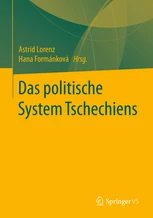 The_political_system_of_the_Czech_ Republic
The_political_system_of_the_Czech_ Republic
Lorenz, Astrid, Formánková, Hana (eds.); Springer VS Publishing; 2018
.
This book provides an in-depth look at the Czech Republic's system of government, society, parties, and media, as well as selected policy areas. It focuses on key features and their connection to the European Union, traces important lines of development, and classifies the findings in comparison with other states. The authors are recognized scholars who bring a high degree of professional and regional expertise.
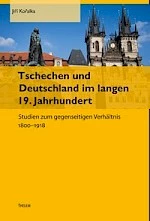 Czechs and Germany in the long 19th century
Czechs and Germany in the long 19th century
Studies on the mutual relationship 1800 - 1918
Jiři Kořalka; Publisher Thelem; 2018.
The name and specialized texts of Jiří Kořalka are sufficiently known to German-speaking people interested in Czech as well as generally Central European history, especially that of the 19th century. His work to date certainly deserves recognition. Instead of praising Jiří Kořalka comprehensively, as justified as that would be, only one thing should be mentioned here: At least from the Czech point of view, he is one of the most important personalities of modern Czech historiography, who succeeded in transcending national borders in their works, both through the subject matter of their many years of research activity, and - and above all - through the resonance it found abroad. For Jiří Kořalka, what is otherwise almost a matter of course in Czech historical production, namely that the subject matter of Czech provenance worked on by a Czech historian is automatically intended exclusively for the Czech audience, is not true.
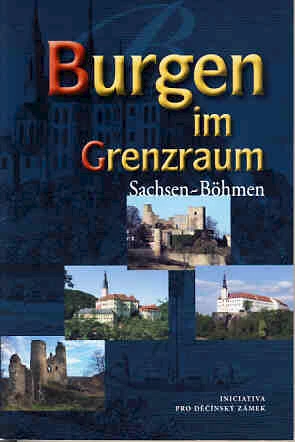 Castles in the Saxon-Bohemian border region
Castles in the Saxon-Bohemian border region
Initiativa pro Děčínský zámek, 2012
The book "Castles in the Saxon-Bohemian border region" focuses on a total of 57 castles on both sides of the Saxon-Czech border. The background of the publication was the 550th anniversary of the signing of the Treaty of Cheb in 1459, which established the Saxon-Bohemian border in its shape still valid today (except for minor adjustments), making it one of the oldest borders in the world. In an introductory chapter, therefore, the historical context of the signing of the treaty is presented.
The focus is on the description of the 30 Bohemian and 27 Saxon castles. Among them are also many that can be found today only as ruins or as barely recognizable traces in the landscape. The following castles are dealt with.
In Bohemia: Bilin, Blankenstein, Robber's Castle near Zeidler, Böhmisch Kamnitz, Tetschen, Teplitz Castle Hill, Falkenstein, Karlstein, Kostenblatt, Schönbuche, Graupen, Oberkarlstein, Geiersberg, Leschtine, Raubschloss, Mosern, Riesenburg, Scharfenstein, Paradies, Wüstes Schloss, Rattenstein, Schreckenstein, Schwaden, Schauenstein, Teplitz, Tollenstein, Außig, Warta, Wolsburg, Sperlingstein.
In Saxony: Altrathen, Arnstein, Bärenstein, Burkhardswalde, Dippoldiswalde, Dohna, Dresden, Frauenstein, Hohenstein, Königstein, Lauenstein, Liebstadt, Maxen, Neurathen, Pesterwitz, Pirna, Rabenau, Rechenberg, Reinhardsgrimma, Reinholdishain, Schwarzberg, Tharandt, Wildenstein, Wartenberg, Weesenstein, Wehlen, Winterstein.
The book is available for 14,90 Euro in selected stores (e.g. Dresden Information at Neumarkt) as well as on the Internet.
ISBN: 978-80-905025-1-2
prolog
Již více než rok je Česká republika členem Evropské unie a dle hospodářských prognóz by se měly začít
naplňovat teorie o budoucí prosperitě příhraničních regionů na bývalé hranici patnácti členských zemí, které
se nalézaly na okraji dění. Pro zajištění prosperity je důležitá spolupráce, které musí předcházet vzájemné
poznávání.
Publikace, kterou berete do ruky, je významným příspěvkem k tomuto poznávání a její vznik reprezentuje
spolupráci české univerzity, katedry geografie Přírodovědecké fakulty Univerzity Jana Evangelisty Purkyně
z Ústí nad Labem s drážďanským Institutem geografie Technické univerzity. V roce 2006 oslaví Drážďany 800
let od svého založení, s nímž bude spojena řada kulturních a politických akcí, jichž se zúčastní i zástupci
z České republiky. Lze předpokládat, že Euroregion Elbe / Labe bude i do budoucna hrát v přeshraniční
spolupráci velmi důležitou roli.
Tento atlas je jakýmsi portrétem a prostorovým zobrazením fyzicko-geografické situace, demografických
poznatků spojených s popisem průmyslu a dalších odvětví hospodářství a společnosti a poslouží jak
podnikatelům a státní správě tak i vědcům zabývajícím se touto oblastí poznávání. Autoři shromáždili velké
množství statistických dat a údajů o regionu, jejichž čtení přináší i osobám žijícím v pohraničí a obeznámeným
s problematikou přeshraniční spolupráce mnoho nového a zajímavého.
Je zcela přirozené, že tento projekt je subvencován v rámci prostředků Phare CBC, které mají přeshraniční
spolupráci účinně napomáhat a je tak příspěvkem k úspěšné integraci Evropy.
Karel Synek
konzul České republiky v Drážďanech
(This is an automatic translation by Google Translator.)
Fiction books
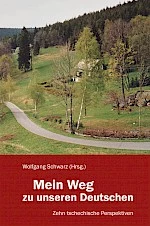 My Way to Our Germans
My Way to Our Germans
Wolfgang Schwarz (ed.); lichtung Verlag; 2019
Ten well-known Czechs write from their own personal perspective about their relations with the Germans.
"Our Germans" the Sudeten Germans are called by the Czechs. For many centuries, both ethnic groups lived peacefully together in Bohemia. Nazi terror, expulsion and communist ideology violently ended this coexistence. From then on, communism demonized all Sudeten Germans as revanchists, while the Sudeten Germans often focused on their own suffering. Since the Velvet Revolution in 1989, the relationship has become much less tense, and the younger Czech generation in particular is addressing the expulsion without fear of contact, uncovering what has been concealed and fighting against misinformation.
How do Czech writers, artists and intellectuals look at their former compatriots? What personal experiences do they associate with them, but also with Germans in general? Ten well-known authors tell of their experiences and perceptions. Especially in times of crisis in European unification, this book is a commitment to an unprejudiced understanding between Germans and Czechs.
Movies
The film project 'Generation "N": Deutschböhme' took place in Saxony and the Czech Republic (DE-CZ Subtitles, 83 min). It brought together wartime witnesses and young people from both neighboring countries and through dialogue the culture of remembrance was cultivated and thus the war and post-war period was critically examined (perspective of different generations, countries and fates).
The original documentary movie about the Sudetengermans - those who were expelled from the Czechoslovakia after 1945, and those who were forced to stayed there. The film is divided into four chapters, each one deals with one single story (it starts with the Czech-stayed witnesses and finished with the German-expelled ones). The project Generation N: Deutschböhme was led by 'Grüne Schule grenzenlos e.V.' and 'Deutsch-tschechisches Begegnungszentrum Komotau/Chomutov' and aims to serve as an educational material. It examined the question of expulsion, loss of the home, being a refugee, and the parallels between 1945 and 2016. The project partners thank for the financial support to the 'Deutsch-tschechisches Zukunftsfond' and 'Landkreis Mittelsachsen'.
Source: Project's Facebook page (facebook.com/GeneraceN/)
The film has won the German-Czech Journalist Award 2017 in the Multimedia category.

